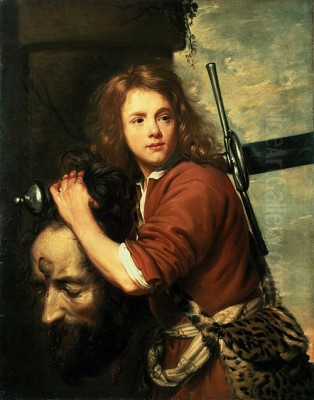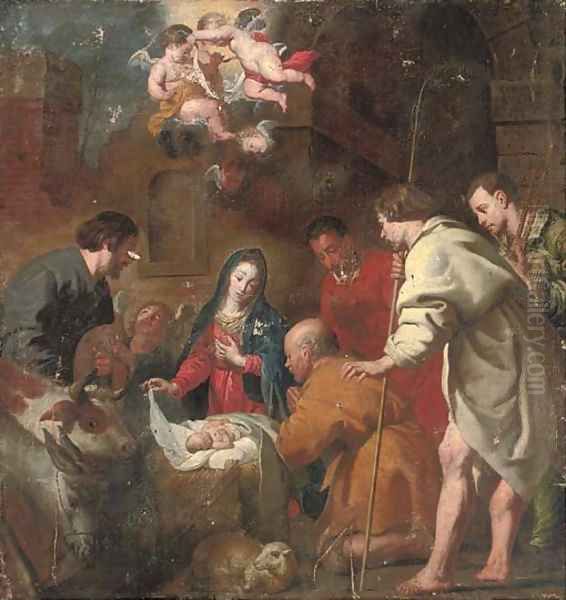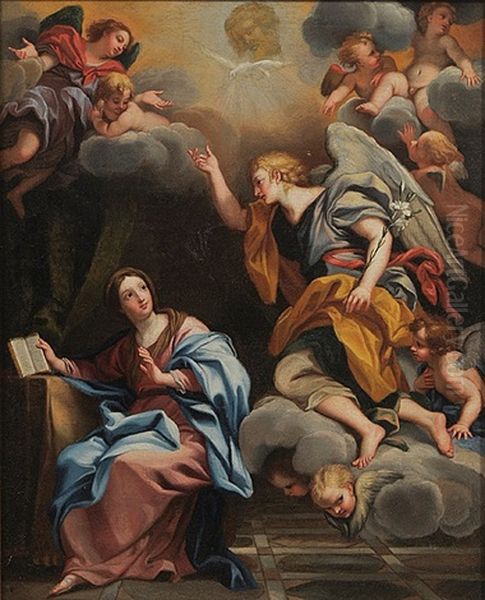
Jacob van Oost, often referred to as Jacob van Oost the Elder to distinguish him from his son of the same name, stands as one of the most significant painters of the 17th century in Bruges. Active during the vibrant period of Flemish Baroque art, Van Oost carved a distinct niche for himself, becoming the leading artist in his city for much of his career. His oeuvre, characterized by a compelling synthesis of Italianate influences and local Flemish traditions, primarily encompassed religious altarpieces and insightful portraits, leaving an indelible mark on the artistic landscape of his time.
Early Life and Formative Influences in Bruges
Born in Bruges around 1603 (though some sources suggest 1601), Jacob van Oost emerged into an artistic environment rich with history. Bruges, though past its absolute zenith as a commercial powerhouse of the late Middle Ages, still maintained a strong artistic identity, built upon the legacy of Early Netherlandish masters like Jan van Eyck and Hans Memling. While the specifics of Van Oost's earliest training remain somewhat obscure, it is generally accepted that he was a pupil of his brother, Frans van Oost, a painter of lesser renown.
The artistic currents of the early 17th century were powerfully shaped by developments in Italy, particularly the revolutionary naturalism of Caravaggio and the classical dynamism of the Carracci family. Furthermore, Antwerp, the dominant artistic center in Flanders, was home to the towering figures of Peter Paul Rubens and Anthony van Dyck, whose dramatic compositions and rich palettes were transforming Flemish art. Young artists across the Low Countries were eager to absorb these new trends.
The Italian Sojourn and its Impact
A pivotal moment in Van Oost's artistic development was his journey to Italy, undertaken around 1621 and lasting for approximately five years. This period of study and immersion was crucial for many Northern European artists. In Rome, Van Oost would have encountered firsthand the works of Michelangelo Merisi da Caravaggio, whose dramatic use of chiaroscuro (strong contrasts between light and dark) and unidealized, psychologically potent figures had a profound impact. He also studied the works of Annibale Carracci and his followers, who offered a more classical, yet equally dynamic, interpretation of Baroque ideals.

This Italian experience was transformative. Van Oost absorbed the lessons of Caravaggio's tenebrism, the theatrical lighting, and the direct emotional appeal of his figures. He also learned from the compositional structures and idealized forms of the Bolognese school, spearheaded by the Carracci. Upon his return to Bruges around 1628, he brought with him a sophisticated understanding of Italian Baroque principles, which he began to integrate into his own burgeoning style. He became a master in the Guild of Saint Luke of Bruges in 1621, and his return marked the beginning of a prolific and influential career in his native city.
Artistic Style: A Synthesis of North and South
Jacob van Oost the Elder's style is a fascinating amalgamation. His grounding in the Flemish tradition provided him with a meticulous attention to detail and a rich, tactile quality in his rendering of textures. However, his Italian studies infused his work with a new monumentality, a heightened sense of drama, and a sophisticated use of light and shadow.
His early works after returning from Italy clearly show the influence of Caravaggio, evident in the strong chiaroscuro and the robust, earthy quality of his figures. Artists like Bartolomeo Manfredi, a prominent follower of Caravaggio, also seem to have left an impression. However, Van Oost did not remain a slavish imitator. Over time, his style evolved, incorporating the more elegant and courtly influences of Rubens and Van Dyck, whose works were widely disseminated through prints and by reputation. This led to a softening of his Caravaggist tendencies, with a brighter palette, more fluid brushwork, and a greater emphasis on graceful movement and refined emotion, particularly in his later religious works and portraits.
He was particularly adept at creating large-scale altarpieces for the churches and monastic orders of Bruges, which were undergoing a period of renewal and redecoration during the Counter-Reformation. These commissions demanded an art that was both doctrinally sound and emotionally engaging, qualities Van Oost was well-equipped to provide. His compositions are typically well-balanced, his figures imbued with a quiet dignity, and his narratives clearly articulated.
Major Religious Works and Altarpieces
Van Oost's contribution to religious art in Bruges was substantial. He received numerous commissions for altarpieces, which became centerpieces in prominent ecclesiastical settings. One of his most celebrated works is "The Calling of St. Matthew," a theme famously depicted by Caravaggio. Van Oost’s version, located in the Sint-Martinuskerk in Voorburg (though he also treated similar themes for Bruges locations), demonstrates his mastery of dramatic lighting to highlight the pivotal moment of spiritual awakening. The figures are rendered with a compelling realism, their gestures and expressions conveying the narrative's intensity.

Another significant religious painting is the "Adoration of the Shepherds." In such works, Van Oost often combined the earthy realism inherited from Caravaggio with a tender piety characteristic of Flemish religious sentiment. His depictions of the Virgin Mary, such as in "Madonna and Saints" for the Bruges Cathedral (Sint-Salvatorskathedraal), often exude a gentle grace, influenced by the elegance of Van Dyck and later Italian Baroque masters like Carlo Maratta.
Other notable religious commissions include "The Presentation in the Temple," "The Descent from the Cross," and various scenes from the lives of saints, such as "Saint Augustine Washing the Feet of Christ as a Pilgrim" and "Saint Anthony of Padua with the Christ Child." These works solidified his reputation as the pre-eminent religious painter in Bruges. His ability to convey profound spiritual themes with clarity and emotional resonance made him a favored artist of the Catholic Church in the region. He was also commissioned by civic institutions, reflecting his esteemed status.
Master of Portraiture
Alongside his religious commissions, Jacob van Oost the Elder was a highly sought-after portraitist. He painted numerous portraits of Bruges' prominent citizens, including burghers, clergy, and fellow artists. His portraits are characterized by their psychological insight, their sober yet dignified presentation, and their meticulous rendering of costume and accessories.
In his portraiture, the influence of Anthony van Dyck is often discernible, particularly in the elegant poses and the refined treatment of fabrics. However, Van Oost maintained a certain Flemish directness and a less idealized approach than his Antwerp contemporary. His subjects often gaze directly at the viewer, establishing an immediate connection. Works like "Portrait of a Bruges Family" (circa 1645) showcase his skill in group portraiture, capturing individual likenesses while creating a harmonious composition.
Individual portraits, such as the "Portrait of a Man" (various examples exist, typically dated to the 1640s and 1650s), reveal his ability to convey the sitter's status and personality through subtle means – the set of the mouth, the intensity of the gaze, the careful arrangement of hands. He also painted "tronies" – character studies or head-and-shoulders paintings of anonymous figures, often in exotic or historical costume – a genre popular in the Netherlands at the time, with artists like Rembrandt and Frans Hals also excelling in it. His "Boy with a Hat" (1650) is a charming example of his ability to capture youthful innocence and character.
Genre Scenes and Other Works

While primarily known for religious paintings and portraits, Van Oost also ventured into genre scenes, though these form a smaller part of his output. These works often depict everyday life or allegorical subjects with a moralizing undertone. Paintings like "Musicians" or "Card Players" reflect a trend popular throughout the Low Countries, explored by artists such as Adriaen Brouwer, David Teniers the Younger, and the Dutch "fijnschilders" (fine painters) like Gerrit Dou.
His genre scenes often retain the strong chiaroscuro of his earlier, Caravaggesque phase, lending them a sense of intimacy and drama. These works demonstrate his versatility and his engagement with the broader artistic currents of his time. The painting "Boys Blowing Bubbles," once attributed to him, is now generally accepted as the work of the remarkable female artist Michaelina Wautier, highlighting the complexities of attribution and the high regard in which Van Oost's style was held, leading to such associations.
Role in the Guild of Saint Luke and Civic Life
Jacob van Oost the Elder was not only a prolific artist but also an active member of the Bruges artistic community. He held several official positions within the Guild of Saint Luke, the professional organization for painters and other craftsmen. He served as a "vinder" (dean or director) of the guild on multiple occasions, including in 1630-1631, 1638-1639, 1642-1643, 1654-1655, 1659-1660, and 1664-1665. These roles underscore his respected status among his peers and his commitment to the city's artistic life.
The provided information also mentions him as an "excellent musician" and holding roles such as "Mayor and Dean of the Mayor's College in Bruges." While his leadership within the Guild of Saint Luke is well-documented and significant, the specific title of "Mayor of Bruges" in the political sense is less substantiated in primary art historical sources concerning his biography as a painter. It's more likely that "Dean of the Mayor's College" refers to a high-ranking position within the guild or another civic body related to arts and crafts, rather than the chief executive of the city. His musical talents, if indeed notable, would reflect the cultured nature of successful artists of the period, who often possessed diverse skills.
His involvement in the Guild would have included responsibilities such as regulating apprenticeships, maintaining quality standards, and representing the interests of the city's artists. This active participation in the institutional framework of art production further cemented his central role in Bruges.
Contemporaries and Artistic Context

Van Oost operated within a rich Flemish Baroque context. While Rubens and Van Dyck dominated Antwerp, other significant painters were active across Flanders. Gaspar de Crayer, for instance, was a prominent figure in Brussels and Ghent, known for his large altarpieces that also blended Flemish and Italian influences. Jacob Jordaens, another Antwerp master, was celebrated for his robust and joyful depictions of mythological and genre scenes.
In the realm of Caravaggism, artists like Theodoor Rombouts and Gerard Seghers were important Flemish proponents of this style, active slightly earlier or contemporaneously with Van Oost's formative period. Van Oost's engagement with Caravaggism places him within this broader European movement, though his later stylistic evolution shows a move towards a more classical and elegant Baroque idiom.
His position in Bruges meant he was the leading figure in a city with a distinct artistic heritage. While Antwerp was the powerhouse, Bruges artists like Van Oost ensured that high-quality, contemporary art continued to be produced locally, catering to the needs of the city's churches, civic institutions, and private patrons. He would have been aware of, and likely competed with, other local painters, though his sustained success suggests he was pre-eminent.
The Van Oost Legacy: Family and Influence
Jacob van Oost the Elder's artistic legacy was continued by his son, Jacob van Oost the Younger (1639–1713). The younger Van Oost also trained with his father and largely followed his stylistic path, producing religious paintings and portraits for the Bruges market. While a competent painter, Jacob van Oost the Younger did not achieve the same level of originality or impact as his father. His works are sometimes confused with those of his father, particularly later pieces.
The Elder's influence extended beyond his immediate family. As the leading painter in Bruges for several decades and an active member of the Guild, he would have trained apprentices and influenced the stylistic direction of other local artists. His successful integration of Italian Baroque grandeur with Flemish realism provided a model for subsequent generations of Bruges painters.
His workshop was likely a busy one, producing numerous paintings to meet demand. This workshop practice, common at the time, involved assistants working under the master's direction, which can sometimes complicate attributions of specific works.
Later Career, Death, and Enduring Reputation
Jacob van Oost the Elder remained active and productive throughout his life. He continued to receive important commissions into his later years, adapting his style to prevailing tastes while retaining his characteristic dignity and technical skill. He passed away in Bruges in 1671, leaving behind a substantial body of work that had significantly shaped the artistic identity of the city in the 17th century.
Today, Jacob van Oost the Elder is recognized as a key figure in the Flemish Baroque, particularly for his role in transmitting and adapting Italian artistic innovations within the context of Bruges. His paintings are found in major museums and collections worldwide, including the Groeningemuseum in Bruges, the Louvre in Paris, the Hermitage in St. Petersburg, and many others. His altarpieces still adorn many churches in Bruges and the surrounding region, testament to his enduring artistic and spiritual legacy.
His ability to synthesize diverse influences – the drama of Caravaggio, the classicism of the Carracci, the elegance of Van Dyck, and the robust tradition of Flemish painting – resulted in a body of work that is both historically significant and aesthetically compelling. He was a master of composition, a sensitive portraitist, and a powerful narrator of religious themes, securing his place as a true luminary of the Bruges Baroque. His art provides a vital link in the chain of Flemish painting, connecting the city's medieval glories with the vibrant developments of the Baroque age.